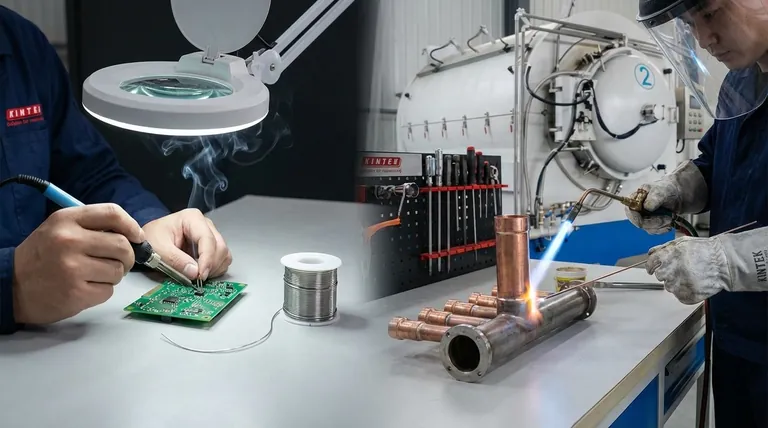핵심적으로, 납땜과 브레이징의 유일한 결정적인 차이점은 온도입니다. 두 공정 모두 모재를 녹이지 않고 필러 재료를 사용하여 금속을 접합하지만, 브레이징은 고온(450°C / 840°F 이상)에서 발생하며 납땜은 이 임계값 미만에서 수행되는 저온 공정입니다. 이러한 근본적인 열의 차이는 접합 강도, 재료 호환성 및 적합한 적용 분야에 직접적인 영향을 미칩니다.
납땜과 브레이징 중에서 선택하는 것은 강도와 민감성 사이의 절충안입니다. 브레이징은 매우 강력하고 구조적인 결합을 생성하는 반면, 납땜의 낮은 열은 전자 제품과 같이 섬세하고 온도에 민감한 부품에 유일하게 실행 가능한 옵션입니다.

결정적인 요소: 온도 및 필러 금속
이 두 공정의 전체 분류는 국제적으로 인정된 하나의 온도에 달려 있습니다. 이 단일 변수는 사용되는 필러 금속의 유형과 그 결과로 생성되는 접합부의 특성을 결정합니다.
450°C (840°F) 임계값
이 특정 온도는 공식적인 구분선입니다. 이 지점 아래에서 녹는 필러 금속을 사용하는 모든 공정은 납땜으로 분류됩니다. 이 지점 위에서 녹는 필러 금속을 사용하는 모든 공정은 브레이징으로 분류됩니다.
납땜: 저온 공정
납땜은 일반적으로 주석, 납, 은 또는 기타 저융점 원소의 합금인 필러 금속, 즉 납땜 재료를 사용합니다. 목표는 종종 고강도 기계적 결합보다는 전기적 연결을 만드는 것입니다.
브레이징: 고온 공정
브레이징은 훨씬 더 높은 융점을 가진 필러 합금을 사용하며, 종종 은, 구리, 니켈 또는 알루미늄을 포함합니다. 관련된 더 큰 열은 모세관 현상이라는 과정을 통해 필러와 모재 금속 사이에 더 강한 야금학적 결합을 촉진합니다.
이 차이가 중요한 이유: 강도 및 적용
작동 온도의 상당한 차이는 두 가지 매우 다른 문제에 대한 두 가지 매우 다른 도구를 만듭니다. 하나는 강도를 위해 만들어졌고, 다른 하나는 섬세함을 위해 만들어졌습니다.
접합 강도: 명확한 차이
브레이징 접합부는 납땜 접합부보다 극적으로 강합니다. 적절하게 브레이징된 접합부는 연결하는 모재 금속만큼 강하거나 심지어 더 강할 수 있습니다. 이는 상당한 응력이나 진동을 견뎌야 하는 구조적 적용 분야에 적합합니다.
대조적으로, 납땜 접합부는 비교적 약합니다. 그 주요 목적은 일반적으로 접착 및 전기 전도성을 위한 것이며, 기계적 하중 지지용이 아닙니다.
납땜의 일반적인 적용 분야
납땜의 낮은 열은 고온에 의해 손상될 수 있는 부품에 이상적입니다. 가장 일반적인 용도는 인쇄 회로 기판(PCB)에 부품을 부착하는 전자 제품입니다. 또한 구리 파이프를 접합하는 배관 및 스테인드글라스와 같은 장식 예술에도 사용됩니다.
브레이징의 일반적인 적용 분야
브레이징의 강도는 산업 제조에서 필수적입니다. 라디에이터 및 에어컨 시스템과 같은 부품의 자동차 산업, HVAC, 그리고 도구 및 중장비의 부품 접합에 널리 사용됩니다.
절충점 이해하기
방법을 선택하는 것은 단순히 가장 강력한 옵션을 선택하는 것이 아닙니다. 브레이징에 필요한 높은 열은 고려해야 할 중요한 제한 사항을 초래합니다.
열 손상의 위험
납땜의 주요 장점은 브레이징의 주요 단점이기도 합니다: 열. 브레이징의 고온은 얇고 섬세하거나 이전에 열처리된 모재를 쉽게 손상시키거나 변형시킬 수 있으므로 민감한 적용 분야에는 이 공정이 적합하지 않습니다.
공정 복잡성 및 장비
납땜은 일반적으로 더 간단한 공정이며, 종종 기본적인 납땜 인두나 토치로 달성할 수 있습니다. 브레이징은 더 정밀한 온도 제어와 더 강력한 열원을 필요로 하므로 복잡성과 비용이 증가할 수 있습니다.
재료 호환성
둘 다 이종 금속을 접합할 수 있지만, 브레이징은 일반적으로 더 다재다능합니다. 높은 열과 특수 필러 합금은 강철과 구리 또는 탄화텅스텐과 강철과 같이 매우 광범위한 재료 간에 강력한 결합을 가능하게 합니다.
귀하의 적용 분야에 적합한 선택
궁극적으로 선택은 전적으로 특정 프로젝트의 요구 사항에 달려 있습니다.
- 주요 초점이 전기 전도성 또는 열에 민감한 부품 접합인 경우: 저온 적용으로 인해 납땜이 올바른 선택입니다.
- 주요 초점이 구조 부품의 최대 접합 강도인 경우: 브레이징이 우수하며, 접합되는 재료만큼 강한 결합을 만듭니다.
- 주요 초점이 이종 또는 고강도 금속 접합인 경우: 브레이징은 까다로운 재료 조합에 대해 더 견고하고 신뢰할 수 있는 솔루션을 제공합니다.
열, 강도 및 부품 민감성 간의 이러한 근본적인 절충점을 이해하는 것이 작업에 적합한 접합 공정을 선택하는 핵심입니다.
요약표:
| 특징 | 납땜 | 브레이징 |
|---|---|---|
| 공정 온도 | 450°C (840°F) 미만 | 450°C (840°F) 초과 |
| 접합 강도 | 낮음 (접착/전기용) | 높음 (구조적, 모재 금속만큼 강함) |
| 주요 적용 분야 | 전자 제품, 배관, 섬세한 부품 | 자동차, HVAC, 중장비 |
| 열 민감도 | 열에 민감한 부품에 이상적 | 섬세한 재료 손상 위험 |
금속 접합 적용 분야에 대한 전문가의 조언이 필요하십니까? 완벽한 납땜 또는 브레이징 결과를 얻으려면 올바른 장비가 중요합니다. KINTEK은 모든 열처리 요구 사항을 위한 고성능 실험실 장비 및 소모품을 전문으로 합니다. 당사의 솔루션은 섬세한 전자 어셈블리와 견고한 산업용 브레이징 모두에 대해 정밀한 온도 제어와 안정적인 성능을 보장합니다.
당사의 전문가가 귀하의 특정 요구 사항에 맞는 이상적인 장비를 선택하는 데 도움을 드리겠습니다.
지금 문의하십시오 KINTEK이 귀하의 실험실 역량과 효율성을 어떻게 향상시킬 수 있는지 논의하십시오!
시각적 가이드

관련 제품
- 진공 열처리 소결 브레이징로
- 고온 응용 분야를 위한 열 증착 텅스텐 와이어
- 진공 열처리 및 몰리브덴 와이어 소결로
- 엔지니어링 첨단 세라믹 가공용 맞춤형 알루미나 지르코니아 특수 형상 세라믹 플레이트
- 진공 열간 프레스 퍼니스 가열 진공 프레스 기계 튜브 퍼니스

























